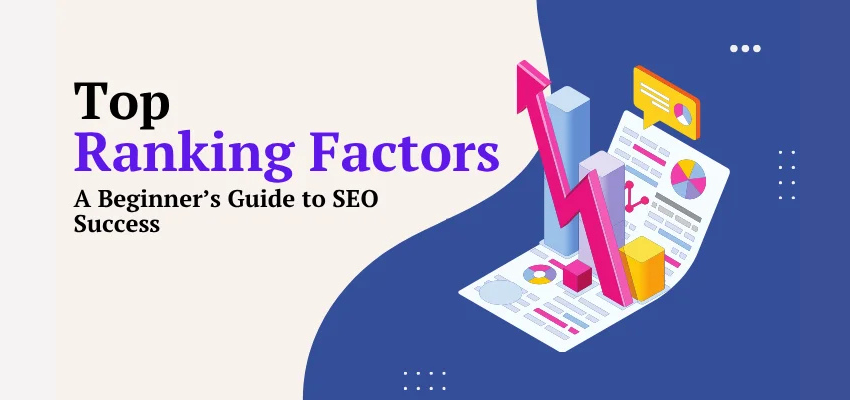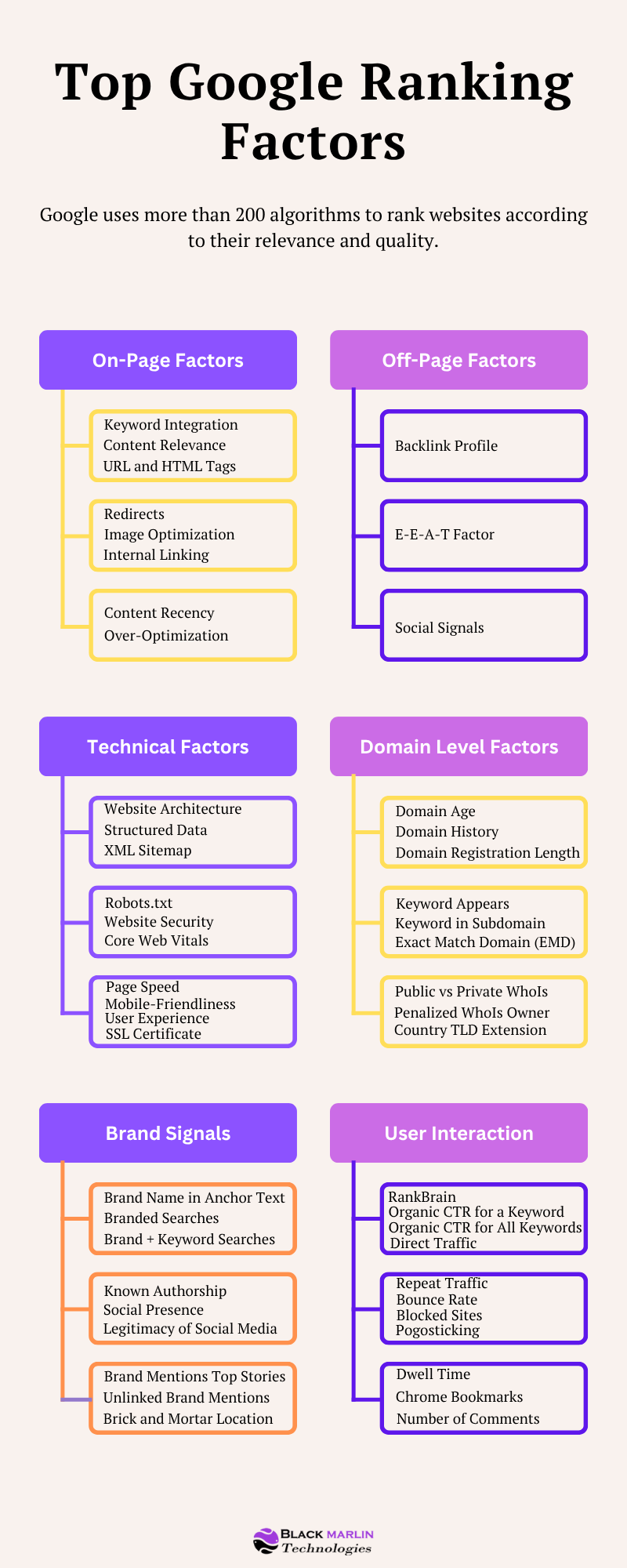The digital landscape is constantly evolving, particularly in the realm of SEO or search engine optimization, which is the most reliable, sustainable, and lucrative tool for business growth.
As a beginner, you may think that a good SEO strategy is all about keyword-rich, relevant content with lots of backlinks. Not all is wrong but you have to recognize that several other ranking factors determine the visibility of your website in organic search results.

Let’s not forget that Google’s algorithms are always changing! Nearly hundreds to thousands of algorithm changes take place annually! However, 200 such ranking factors Google more often uses to determine a website’s SEO success.
Some of them are well-established. Some of them are disputable. Some matter. Some do not matter.
So, we at Black Marlin Technologies are here to discuss the most influential ranking factors that genuinely affect your website’s search result rank.
We will help you understand the factors you must prioritize while optimizing your website or web page to prevent it from sinking into the SEO landscape.
Indeed, algorithm updates are inevitable and it may seem challenging to get to the top of SERP (Search Engine Results Page). So, here is a complete list of the ranking factors you must know about.
What is a Google Ranking Factor?
Google uses complex algorithms to evaluate the relevance of a web page in response to a search query. These algorithms or factors help Google decide the rank of a web page in the organic search results. It implies that the more relevant, valuable, and user-friendly a page, the higher its rank.
To create an effective SEO strategy, content creators, SEO specialists, and marketers must understand and consider the ranking factors because they promote online visibility and help generate leads and conversions.
Nonetheless, emphasizing the Google ranking factors does not mean you have to follow a random list. In fact, it is all about comprehending how Google values information, relevance, purpose, trustworthiness, and user experience to translate them into improved rankings.
Why Should You Keep an Eye on the Ranking Factors?
Google algorithms have constantly evolved. Some updates may not induce a significant change in a website’s rank, while major updates impact the ranking criteria considerably.
For example, between 2023 and 2024, Google released core updates, spam updates, and review updates to combat deceitful practices and refine search quality.
Similarly, the gradual shift to mobile-first indexing and integration of artificial intelligence and machine learning through RankBrain and Hummingbird have made it possible to rank a page for a query, even if it does not match the exact words of the searcher. Indeed, it is a phenomenal development that has relatively improved user experience.
Well, despite persistent algorithm changes, remember that some factors are here to stay. They will never be off the list! Another interesting point is that some factors may bring their influence only in the presence of others!
However, keeping track of the ranking factors is crucial to make your SEO strategy more powerful and ensure you are doing everything right! Here is a list of the top ranking factors you should take care of!
The Top Ranking Factors You Cannot Overlook
As already said, Google uses more than 200 algorithms to rank websites according to their relevance and quality. However, it is debatable because there have been thousands of updates. So, we have prioritized the factors that directly impact your website’s ranking.
Let’s dive deeper.

1. On-Page Factors
- Keyword Integration– Keywords are the words or phrases that are used throughout a webpage to help search engines like Google understand what the content is all about to rank you in the relevant search query. Placing keywords strategically in titles, meta descriptions, headings, body text, and Alt text helps increase your scope for appearing in the top ranks.
Nonetheless, you must avoid keyword stuffing to escape the Google penalty. Perform a thorough keyword research and choose the ones with high search intent. It makes you more visible and increases website traffic.
- Content Relevance– To fetch an impressive SERP rank, always prioritize content quality. It is one of the top ranking factors and Google loves valuable, relevant, purposeful, informational, and authentic content. Your content must serve the purpose of the website visitors.
Well-researched and original content provides value to readers while enhancing user experience. Write in simple and clear language that is easy to understand and engaging. Use primary and long tail keywords to resonate with search intent and reduce bounce rates.
- URL and HTML Tags– As a part of on-page SEO elements, HTML tags and URL structure play a vital role in categorizing your web page accurately. Keyword-rich title tags and headers boost search result visibility.
On the other hand, well-structured URLs provide context to search engines and visitors. It improves rank and user experience and attracts links from sites with high domain authority. So, a URL must be concise, clear, keyword-rich, and relevant.
- Redirects– Redirects significantly impact user experience. Use them appropriately and avoid redirect chains as they decrease website speed. Implement 301 redirects for permanent URL changes, while 302 for temporary changes. Always redirect to the most relevant content or page.
Remember that deceptive redirects can result in de-indexing as they are generally considered manipulative.
- Image Optimization– If your content has an image, do not forget to optimize it so that Google can appropriately understand and index it. The Alt text must correctly describe what the image is about for a user and search-engine-friendly content.
Minimize image sizes to enhance page load speed and offer seamless navigation.
- Internal Linking– Among other Google ranking factors, internal linking is fundamental as it determines the overall website structure responsible for smooth navigation. By linking one page with another, you help users and Google spiders learn and discover more about you.
Indeed, it boosts the engagement rate, which improves the likelihood of lead generation. Alongside this, search engine bots can easily move from one page to another and index them.
- Content Recency– Staying up-to-date is extremely important to keep up your rank. Google prioritizes fresh and relevant content. So, if there are blogs, articles, or other forms of content that have not been updated for a long time, it’s time to review and refine them.
Include recent statistics and research on trending topics to give outdated content a fresh touch. It will significantly boost visibility and user engagement.
- Over-Optimization– Unnatural keyword density in content, over-using keywords in header tags, keyword stuffing, and spammy content can negatively impact your ranking. Avoid over-optimizing your website to maintain its reputation.
2. Off-Page Factors
- Backlink Profile– Links from other authoritative websites that trace back to your site are known as backlinks. These links are trust signals that determine your website’s performance in search results. When you earn high-quality backlinks, Google perceives your website to be valuable, trustworthy, and relevant.
To earn authoritative backlinks, use guest blogging, infographics, guides, and broken link building. Perform competitor’s backlink analysis and identify the sources they receive their backlinks.
Identify unlinked mentions, publish press releases, and share ultimate guides- these are other effective ways to strengthen your backlink profile. Additionally, prioritize link quality instead of quantity for successful endorsement of your website.
- E-E-A-T Factor– Google emphasizes a brand’s E-E-A-T (Experience, Expertise, Authoritativeness, and Trust) signals to rank the web pages. You are considered a reputed and reliable brand if you deliver purposeful information to your audiences. It showcases your knowledge and expertise in the industry which helps to gain trust and improve online visibility.
- Social Signals– Brand power is strongly recognized by your online social presence. Social signals not only generate brand awareness and increase website traffic but also affect Google search ranking indirectly. Likes, shares, reviews, and encouraging personalized interactions enhance the engagement rate and make your brand more credible.
Sharing relevant and engaging content regularly and addressing audience concerns and queries generate an impressive follower base for positive brand growth.
3. Technical Factors
- Website Architecture– With a properly organized site architecture, Google crawlers find it easy to categorize the pages and index them appropriately. A silo structure which sets a defined hierarchy of content categories and subcategories allows efficient indexing of web pages and a seamless user experience.
- Structured Data– Schema markup or structured data helps search engines understand your web page content for relevant display in the search results. Typically, it is the process of organizing and classifying page content.
- XML Sitemap– A sitemap guides Google bots to the pages that are important and must be indexed. Adding XML sitemaps to the valuable web pages ensures they are accurately ranked and displayed in the organic search results.
- Robots.txt– To avoid overloading your website, use robots.txt. It instructs the crawlers about which parts of your website they should and shouldn’t access. Robots.txt helps manage the crawl budget and restricts the indexing of unwanted pages.
- Website Security– In the light of search engine optimization for top Google SERP rank, website security plays a vital role. Web pages using HTTPS are considered as it assures that the user’s information is safe and protected.
In fact, Google penalizes web pages that lack security. Also, they considerably have higher bounce rates.
- Core Web Vitals– To determine page experience, Google relies on a set of distinctive, measurable, and user-oriented metrics called core web vitals. Google prioritizes a website with a user-friendly interface, delivering a flawless experience.
- Page Speed– The loading time of a web page or page speed is a highly significant aspect of the ranking of the web page. The faster your website, the better the engagement and user experience. It is another page experience signal that fetches you the top spots.
- Mobile-Friendliness– In recent times, Google uses mobile-first indexing. When your website is easily accessible on any mobile device, it increases the likelihood of online visibility as you appear among the most sought-after ranks.
Mobile usability has been one of the primary ranking factors since 2015. So, ensure your desktop site is well-optimized to fit into the screens of any mobile device.
- User Experience– Not to mention that Google always deliver websites in search results that provide positive user experiences. The web pages should have a simple and attractive layout with well-organized, relevant, and helpful content. Also, fast page speed and easy navigation are other facets of an extraordinary user experience.
- SSL Certificate– Build user confidence and protect sensitive information by using an SSL certificate. It encrypts data transmitted between your website and a user’s browser.
An SSL certificate curtails the risks of penalties and enhances user experience considerably. It signals search engines that your website is secure and reliable.
4. Domain Level Factors
- Domain Age– The age of your domain does not directly impact your Google rank. John Mueller of Google confirmed that domain age has nothing to do with rank. You may find older domains with better ranks because they have more content and backlinks.
- Domain History– Though domain history is not a notable ranking factor, if you bought a domain with controversial history or registration gaps, it may be difficult to rank. The problem escalates if there have been frequent ownership changes, abandonment, or it was used for black hat intentions.
Therefore, always visit archive.org to view domain history before purchase.
- Domain Registration Length– Generally, websites with long-term domain registration lengths are considered to have more reliable owners. This is because they are associated with high-quality content.
- Keyword Appears in Top Level Domain– Often, adding a keyword in the domain name exhibits your website’s relevance. However, as a direct Google ranking factor, the possibilities have been dropped off.
- Keyword in Subdomain– Using a relevant keyword in the subdomain is believed to improve organic search rank.
- Exact Match Domain (EMD)– Typically, EMD or an Exact Match Domain has no straight link to search engine rank. Nonetheless, your EMD may be vulnerable to algorithm updates if it has spammy or poor-quality content.
- Public vs Private WhoIs– There is nothing wrong with having private WhoIs. However, there may be questions about your website’s authenticity if the content quality is low and the domain has a short registration length.
- Penalized WhoIs Owner– Google will scrutinize other websites owned by a person who is identified as a spammer.
- Country TLD Extension– Your domain will particularly rank well in a country if you have a Country Code Top Level Domain (ccTLD) like .pt for Portugal, .cn for China, etc. However, it may impact your global visibility.
5. Brand Signals
- Brand Name in Anchor Text– When you have your brand name in the anchor text of links, it is a potential brand signal that encourages awareness and recognition.
- Branded Searches– When users actively search for your brand name, it sends a strong positive signal to Google that demonstrates your legitimacy and trustworthiness.
- Brand + Keyword Searches– Searches that constitute your brand name and a specific keyword. For example- Samsung smartphone company, Black Marlin Technologies digital marketing, etc.
- Known Authorship– Verified and recognized online profiles of individuals or authors promote credibility and authority. Users emphasize search results correlated to established sources.
- Social Presence– Brands with active social media presence have better Google rankings as they contribute to recognition and identity. When you have considerable followers on Facebook, Instagram, Twitter, LinkedIn, and YouTube, it naturally encourages awareness and long-term relationships.
- Legitimacy of Social Media Accounts– Google strictly scrutinizes the authenticity of social media profiles. You get penalized for fake profiles, leading to a descending rank.
- Brand Mentions on Top Stories– When you appear in ‘Top Stories’, it delivers a positive brand image as Google relates your influence and prominence.
- Unlinked Brand Mentions– One of the most valuable brand signals is brand mentions in content without hyperlinks. These mentions are recognized as brand awareness and validation.
- Brick and Mortar Location– The physical location of a brand is principal in local SEO. Google often uses the data to analyze the overall influence of your brand.
6. User Interaction
- RankBrain– The AI-based ranking algorithm called RankBrain is a prominent Google ranking factor. It ranks URLs based on user interaction signals.
- Organic CTR for a Keyword– Click-through rate (CTR) has always been a potential organic search result ranking factor. The higher the CTR for a keyword, the better the chances of ranking.
- Organic CTR for All Keywords– If there is a consistent CTR across a wide array of keywords, it implies that your content aligns with the user’s interests. As a result, you can experience a significant increase in rank.
- Direct Traffic– The total number of direct traffic your website receives determines audience trust. Google perceives it as a quality indicator for your website content, resulting in ranking improvements.
- Repeat Traffic– When you have high return visitors, it considerably encourages user engagement with valuable and relevant content.
- Bounce Rate– The bounce rate of a web page increases when there is a lack of engagement and a poor user experience. Google reassesses web pages with a high bounce rate to evaluate relevance and quality.
- Blocked Sites– Google uses user-based quality signals to block websites, especially due to privacy or security concerns.
- Pogosticking– A user may immediately return to search results after visiting a website if it fails to meet the search intent. It is called Pogosticking. Your rank is negatively impacted if the Pogosticking rate is high.
- Dwell Time– Dwell time is a critical ranking metric which resembles the amount of time spent on your website after a Google search. When you deliver user satisfaction, the dwell time naturally increases.
- Chrome Bookmarks– The number of times users bookmark your page significantly boosts the Google rank.
- Number of Comments– When you have user comments or interactions, it evidently implies engagement due to exceptional content quality. Thus, comments affect your rankings to some extent.
Conclusion: Monitoring Google Rank to Improve Performance
Before we part, let’s face the truth. Retaining a consistent online presence through improved Google search rankings is an ongoing process. Keyword rankings, user behavior, and industry trends constantly evolve. What works today may not work tomorrow. Similarly, what worked yesterday may work tomorrow.
Hence, to achieve success and keep your Google rank intact, you must monitor your SEO performance. Tracking the key performance indicators (KPIs) provides insights into the scope for improvements. You can adjust your strategies to stay ahead of the curve.
To summarize, here are the most influential ranking factors you cannot ignore:
- Keyword Optimization
- Content Quality
- Website Architecture
- Internal Linking
- Backlinks
- User Experience
- Domain Authority
- Website Security
- Page Speed
- Mobile Responsiveness
Note: Do not overdo optimization. Google may consider it manipulative and de-rank or penalize you.
So, now you’ve got far off beyond knowing just the basics of search engine optimization! If you need an expert SEO company to guide you through the process, our in-house professionals are always up for new endeavors.
Contact us at +91-88-266-83820 if you need help to grow your business digitally.
Frequently Asked Questions (FAQs)
Q. What are Google ranking factors?
A. Google ranking factors are a set of complex algorithms that evaluate the relevance of a web page appropriately in response to a search query. These factors or algorithms help Google determine the rank of a specific web page in the organic search results. The more relevant, valuable, and informational a web page is, the higher its rank.
Q. How many Google ranking factors are there?
A. There are more than 200 factors that directly or indirectly affect the rank of a web page in the Google search result. However, some factors remain debatable, and some are based on speculations.
Q. What are the most important factors I should be aware of?
A. The top 10 Google ranking factors you must always take care of are:
- Keyword Optimization
- Content Quality
- Website Architecture
- Internal Linking
- Backlinks
- Page Speed
- Mobile Responsiveness
- Domain Authority
- Website Security and
- User Experience
Q. What are brand signals? How are they important?
A. Brand signals represent the identity, reputation, value, and trustworthiness of a brand. They contribute to a brand’s online authority and presence. In other words, a powerful brand presence signals Google about its quality and relevance, which significantly influence search result rankings.
Q. How to strengthen the backlink profile?
A. Backlinks are essentially one of the dominating factors responsible for SERP ranking. It is a trust signal that determines your website’s authority, relevance, value, and credibility. Earning high-quality backlinks from resourceful websites increases referral traffic, and Google recognizes you to be trustworthy and reputed. Some of the best practices to strengthen your backlink profile are creating relevant, engaging, and valuable content, encouraging guest blogging and press releases, using brand mentions, citations, and broken link building, participating in community engagement, and optimizing anchor text.
 +1-(646) 362-1414
+1-(646) 362-1414 +91 8826683820
+91 8826683820







